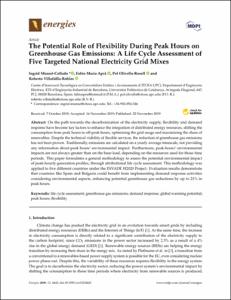Mostra el registre d'ítem simple
The potential role of flexibility during peak hours on greenhouse gas emissions: A life cycle assessment of five targeted national electricity grid mixes
| dc.contributor.author | Munné Collado, Íngrid |
| dc.contributor.author | Aprà, Fabio Maria |
| dc.contributor.author | Olivella Rosell, Pol |
| dc.contributor.author | Villafafila Robles, Roberto |
| dc.contributor.other | Universitat Politècnica de Catalunya. Doctorat en Enginyeria Elèctrica |
| dc.contributor.other | Universitat Politècnica de Catalunya. Departament d'Enginyeria Elèctrica |
| dc.date.accessioned | 2020-04-21T11:58:50Z |
| dc.date.available | 2020-04-21T11:58:50Z |
| dc.date.issued | 2019-11-22 |
| dc.identifier.citation | Munné, I. [et al.]. The potential role of flexibility during peak hours on greenhouse gas emissions: A life cycle assessment of five targeted national electricity grid mixes. "Energies", 22 Novembre 2019, vol. 12, núm. 23, p. 4443:1-4443:22. |
| dc.identifier.issn | 1996-1073 |
| dc.identifier.uri | http://hdl.handle.net/2117/184123 |
| dc.description.abstract | On the path towards the decarbonization of the electricity supply, flexibility and demand response have become key factors to enhance the integration of distributed energy resources, shifting the consumption from peak hours to off-peak hours, optimizing the grid usage and maximizing the share of renewables. Despite the technical viability of flexible services, the reduction of greenhouse gas emissions has not been proven. Traditionally, emissions are calculated on a yearly average timescale, not providing any information about peak hours’ environmental impact. Furthermore, peak-hours’ environmental impacts are not always greater than on the base load, depending on the resources used for those time periods. This paper formulates a general methodology to assess the potential environmental impact of peak-hourly generation profiles, through attributional life cycle assessment. This methodology was applied to five different countries under the INVADE H2020 Project. Evaluation results demonstrate that countries like Spain and Bulgaria could benefit from implementing demand response activities considering environmental aspects, enhancing potential greenhouse gas reductions by up to 21% in peak hours. |
| dc.language.iso | eng |
| dc.rights | Attribution 4.0 International (CC BY 4.0) |
| dc.rights.uri | http://creativecommons.org/licenses/by-nc-nd/3.0/es/ |
| dc.subject | Àrees temàtiques de la UPC::Energies |
| dc.subject.other | Life cycle assessment |
| dc.subject.other | Greenhouse gas emissions |
| dc.subject.other | Demand response |
| dc.subject.other | Global warming potential |
| dc.subject.other | Peak hours |
| dc.subject.other | Flexibility |
| dc.title | The potential role of flexibility during peak hours on greenhouse gas emissions: A life cycle assessment of five targeted national electricity grid mixes |
| dc.type | Article |
| dc.subject.lemac | Gasos -- Aspectes ambientals |
| dc.contributor.group | Universitat Politècnica de Catalunya. CITCEA - Centre d'Innovació Tecnològica en Convertidors Estàtics i Accionaments |
| dc.identifier.doi | 10.3390/en12234443 |
| dc.description.peerreviewed | Peer Reviewed |
| dc.relation.publisherversion | https://www.mdpi.com/1996-1073/12/23/4443 |
| dc.rights.access | Open Access |
| local.identifier.drac | 26407053 |
| dc.description.version | Postprint (published version) |
| local.citation.author | Munné, I.; Aprà, F.; Olivella, P.; R. Villafafila-Robles |
| local.citation.publicationName | Energies |
| local.citation.volume | 12 |
| local.citation.number | 23 |
| local.citation.startingPage | 4443:1 |
| local.citation.endingPage | 4443:22 |
Fitxers d'aquest items
Aquest ítem apareix a les col·leccions següents
-
Articles de revista [156]
-
Articles de revista [226]
-
Articles de revista [883]


